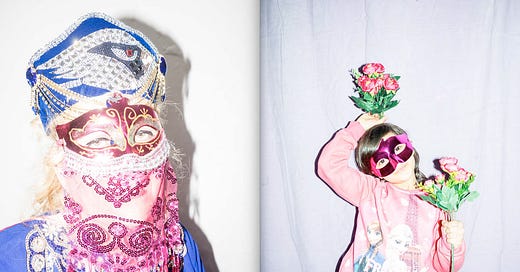Charlotte Schmitz is an artist whose photographic work is intimate, collaborative and refreshingly unorthodox. Her practice often blurs the line between observer and participant. Her first book La Puente explores life in Ecuador’s largest brothel using polaroids that the women painted on with nail polish. Charlotte recently finished a National Geographic project on centenarians living on Galápagos Island, see here. Her new book, Balat, is the result of photographing life behind doors in one of Istanbul’s oldest neighbourhoods. Nathalie takes a look at this beautiful and deeply personal body of work.
I used to live in Istanbul for a few years. On my very first day there, back in 2014, I met Charlotte Schmitz, a photographer. That afternoon, we squeezed out of a top window and sat on the roof of her little pink house in Balat, a historic neighbourhood on the Golden Horn. We shared beers looking over the crumbling wooden Ottoman houses. Paint peeling, balconies sagging. Some partially collapsed.
What used to be the Jewish, Armenian and Greek Orthodox quarter, had by 2014 become a multicultural community of Turkish, Kurdish, Roma and Syrian people. I moved into a turquoise house a couple of streets from Charlotte and fell in love with the place right away. It was messy, loud and full of life. Children played in the streets, music spilled from open windows, neighbors argued and laughed across balconies. Every corner seemed to hold a story. Unfortunately today, gentrification has done its work.
Charlotte told me about the people of Balat. When I met her, she’d been photographing the community for two years and has continued up until this year.
Charlotte says:
Arriving in Balat in 2012, I was soon welcomed into the homes of women and families in the neighborhood. Upon knowing that I’m a photographer, they invited me to weddings, baby showers, and family gatherings, and asked me to photograph their celebrations, as they jokingly called me mahalle fotoğrafçısı (meaning “neighborhood photographer” in Turkish).
As I slowly gained their trust, I was introduced to a world behind the curtains, where women of the neighborhood celebrated in private and in their own ways to escape the monotony of everyday life and the responsibilities often burdened on them as women of the house. Often shielded from outsiders, their playful moments with one another suddenly pop loudly in colors and music—something I sought to capture through the use of flashlight. Yet these extraordinary moments are also just ordinary, as many of the photographs I took became part of their own family albums.
What makes Charlotte’s photographs so special is the way she finds magic in the everyday. Her images capture intimate moments of joy, play and tenderness - women dancing, resting, getting ready, celebrating - and turns them into something luminous. She loves colour and detail: pinks, ruffles, ornaments, gold. Her use of flash photography transforms ordinary situations into something dreamlike and heightened. When her pictures are overexposed, it illuminates.
There’s a sense of weightlessness in her photographs, a softness and grace. The women and girls in her images seem almost to float. They are playful, proud and free. The flash doesn’t freeze or flatten them, it creates an otherworldly glow. You feel Charlotte’s closeness to people, their trust and affection. Even when the scene is full of life, you sense a quietness between the frames. Her gaze holds space for beauty, self-invention and joy. It is like watching someone show you not just how things are but how they feel. How the women and girls in the photographs would like to be seen and remembered.
She has now made her second book with the Balat pictures and is raising funds for a print run on Kickstarter: https://www.kickstarter.com/projects/balat/balat/
Please support her project :)
And for those in the northern hemisphere, have a great summer.
What we’re reading and listening to
Birds! Nathalie has found her favourite app: Merlin Bird ID. The app is free and it identifies the birdsong around you. Put it on record and the app shows which species is singing in real-time. Absolute twitcher heaven!
Ingrid is reading Patricia Evangelista's Some People Need Killing, which chronicles how death squads and vigilantes killed thousands during president Rodrigo Duterte's war on drugs.
Tristen’s daily podcast at the moment is the History of Bad Ideas, a series on Past, Present and Future hosted by David Runicman. Check out the one on decisive battles, a whole different take. Think Stalingrad turned WWII… think again.








